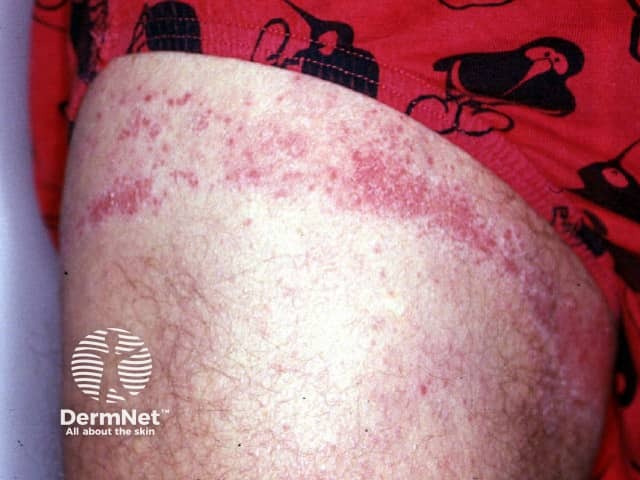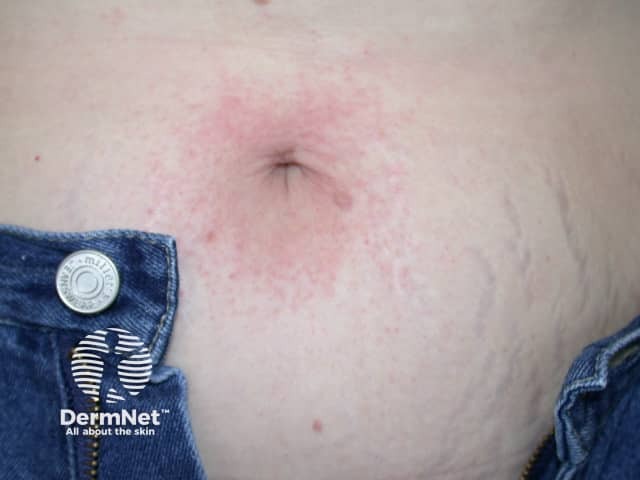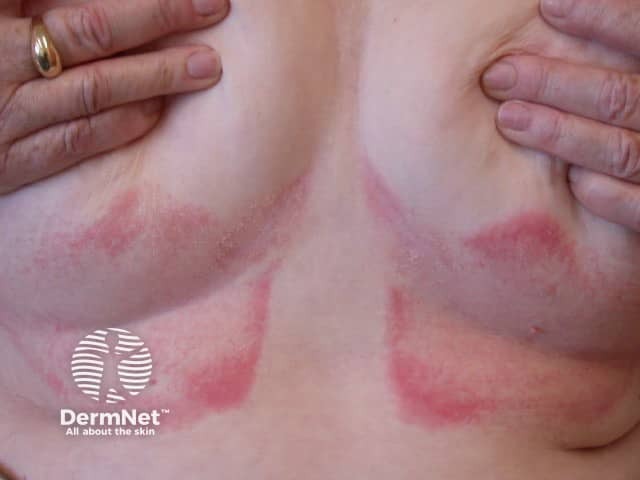Main menu
Common skin conditions

NEWS
Join DermNet PRO
Read more
Quick links
Textile contact dermatitis — extra information
Introduction
Causes
Symptoms
Demographics
Treatment
Prevention
What is textile contact dermatitis?
Textile contact dermatitis or clothing dermatitis can be defined as skin manifestations caused by wearing clothing and/or other fabrics that come into contact with skin. The source of the skin problem may be the fabric itself (i.e. reaction to textile fibres) or more commonly a contact allergy to the chemical additives used in processing the fabric, e.g. textile dyes and finishing agents.

Rubber dermatitis

Nickel dermatitis

Intertrigo
What causes textile contact dermatitis?
Textile fibre can be natural, synthetic or a combination of the two materials. Natural fibres include silk, wool, cotton and linen. Synthetic or man-made fibres include rayon, nylon, polyester, rubber, fibreglass, and spandex. Although all fibres can cause irritant and allergic contact dermatitis, it is rare for them to cause allergic contact dermatitis.
Allergic skin reactions to clothing is most often a result of the formaldehyde finishing resins, dyes, glues, chemical additives and tanning agents used in processing the fabric or clothing. Cases of allergic contact dermatitis have been reported for the following fabric additives.
- Formaldehyde resins used in fabrics to make them wrinkle-resistant
- Para-phenylenediamine (PPD) used in textile and fur dyes
- Azo and anthraquinone based dispersal dyes. These dyes are loosely bound to the fabric structure and can easily rub off onto the skin. They are rarely used in textiles nowadays
- Flame retardants [tris(2,3-dibromopropyl) phosphate (13) and 2,3-dibromocresylglycidyl ether]
Other contact allergens that may be incorporated into the fabric of clothing and cause contact dermatitis include chrome, cobalt, latex and rubber accelerators.
Metallic fasteners and elastic in clothing can also cause contact dermatitis where they are in contact with skin. Metallic stud fasteners on blue jeans are a common cause of nickel dermatitis.
What are the symptoms of textile contact dermatitis?
Textile contact dermatitis is typically characterized by delayed reactions such as redness, scaling and itchiness. The symptoms may appear within hours of contact with the material, or sometimes a reaction may not be seen until days later.
The areas of the body most often affected are the crooks of the arm, backs of the knees, armpits, groin area and buttocks; places that are in most contact with the clothing. In addition, the dermatitis may worsen with constant rubbing by the fabric against the skin and by sweating in hot/humid environments. Sometimes the friction from clothing can cause a condition called intertrigo. In some situations the rash can become secondarily infected with yeast or bacterial organisms.
Who gets textile contact dermatitis?
Textile contact dermatitis is more common in women than in men. This is most probably because women wear more “fitting” and colourful clothing. Anyone may be affected but people with atopic dermatitis or sensitive skin are at greater risk. Other groups of people that may be at greater risk include obese or heavier individuals and those that work in hot/humid environments such as bakeries, restaurant kitchens, foundries and laundries. Textile contact dermatitis is a significant problem for workers in the textile industry.
Diagnosis by performing special allergy tests, i.e. patch tests, may involve testing against a number of different chemicals due to the many potential allergens that may be present in the fabric. It is often very difficult to determine the exact cause because textiles nowadays have been manufactured using a cocktail of dyes, resins and other substances. Also, clothing is not labeled with a list of chemicals it may possess.
See individual contact allergens for patch testing recommendations.
What is the treatment for textile contact dermatitis?
Contact dermatitis should clear rapidly once the offending fabric/clothing is removed. Over-the-counter creams and ointments containing mild topical steroids, such as hydrocortisone 0.5-2.5%, may be used to help control itching, swelling, and redness. In more severe cases, a prescription steroid cream may be required, as well as oral antibiotics if the skin becomes infected.
What should I do to avoid textile contact dermatitis?
If you suffer from textile contact dermatitis the best way to prevent any problems is by avoiding all clothing or fabrics that contain the allergen you are sensitive to. Sometimes this will be difficult to do as textiles are treated with a concoction of chemicals and dyes that are not individually identified. Some steps you can take to reducing contact dermatitis reactions include:
- Wear clothing that is made out of natural fabrics such as cotton and linen
- Wear clothing that is light coloured as these will contain less dye
- Wear loose fitting clothing in hot/humid environments
- Avoid clothing that is labeled “non-iron” and “dirt-repellent” as it is likely these have been chemically treated
- Avoid clothing marked “wash separately” as this implies dyes easily bleed from the fabric
Your dermatologist may have further specific advice, particularly if you are highly sensitive to particular textile allergens.
References
- Clothing Dermatitis and Clothing-Related Skin Conditions (PDF file) – Washington State Department of Labor and Industries
- Malinauskiene L, Bruze M, Ryberg K, Zimerson E, Isaksson M. Contact allergy from disperse dyes in textiles – a review. Contact Dermatitis 2013;68:65–75. PubMed
- Malinauskiene L, Zimerson E, Bruze M, Ryberg K, Isaksson M. Are allergenic disperse dyes used for dyeing textiles? Contact Dermatitis 2012;67:141–8. PubMed
On DermNet
- Textile dye allergy
- Skin problems in textile workers
- Dermatitis
- Irritant contact dermatitis
- Allergic contact dermatitis
- Patch testing
- Contact allergens
Other websites
- Allergic contact dermatitis — Medscape Reference, the online textbook
